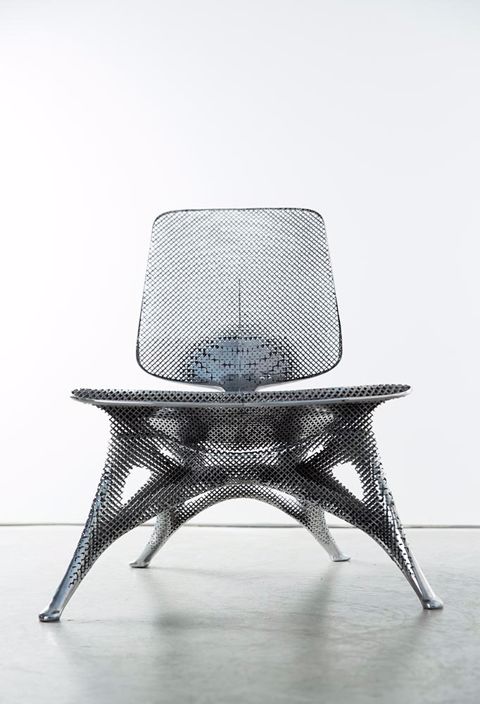The MFAH Highlights Art, Science, and Technology in Exhibition of Cutting-Edge Design Projects by Pioneering Dutch Designer Joris Laarman

Joris Laarman, produced by Joris Laarman Lab, Aluminum Gradient Chair, from the series Microstructures, 2014, laser-sintered aluminum, Barry Friedman, New York. © Joris Laarman
Joris Laarman, produced by Joris Laarman Lab, Branch Bookshelf, 2010, bronze, the Groninger Museum, the Netherlands. © Joris Laarman
Joris Laarman, produced by Joris Laarman Lab, Makerchair (Polygon), 2014, oak, courtesy of Joris Laarman Lab. © Joris Laarman
Joris Laarman, produced by Joris Laarman Lab, Bone Rocker, from the collection Bone Furniture, 2008, black marble and resin, the Museum of Fine Arts, Houston, Museum purchase funded by the Mary Kathryn Lynch Kurtz Charitable Lead Trust. © Joris Laarman
Joris Laarman, produced by Joris Laarman Lab, Dragon Bench, designed 2014, made 2015, stainless steel, the Museum of Fine Arts, Houston, Museum purchase funded by the Caroline Wiess Law Accessions Endowment Fund. © Joris Laarman
65 works in “Joris Laarman Lab: Design in the Digital Age” showcase the highly innovative technology and furniture forms created by the designer over the course of his career
HOUSTON—April 12, 2018—From furniture generated by algorithms to designs brought to life by a robot, the work of experimental Dutch designer Joris Laarman is known for challenging the boundaries of art, science, and technology. In June, the Museum of Fine Arts, Houston, hosts Joris Laarman Lab: Design in the Digital Age, the first U.S. museum survey to offer an in-depth look at the designer’s innovative oeuvre. Showcasing 65 examples including furniture, design experiments, suites of drawings, and videos, the exhibition will make its final stop in Houston from June 24 to September 16, 2018, following its presentation at the Groninger Museum, the Netherlands; the Cooper Hewitt, Smithsonian Design Museum; and the High Museum of Art. The Houston presentation features a number of Laarman’s designs from the collection of the MFAH, which has been a champion of the designer’s work for the past decade.
Organized by the Groninger Museum, Joris Laarman Lab: Design in the Digital Age explores the highly progressive qualities of Laarman’s work, both aesthetically and technologically. Along with his advanced production processes, which often involve digital fabrication methods and robotics, Laarman remains inspired by nature, giving equal attention to organic form and beauty. Together with engineers, programmers, and craftspeople at the Joris Laarman Lab, which was founded in 2004 by the designer and his partner and filmmaker, Anita Star, Laarman creates groundbreaking projects that reimagine traditional forms, many of which are one-of-a-kind and some of which are created only in very limited production. Joris Laarman Lab presents furniture designs and applied projects made throughout Laarman’s career alongside related videos, sketches, and renderings that illustrate the Lab’s creative and production processes.
“We are pleased to be the final U.S. venue to present this impressive survey of Joris Laarman’s work,” said Gary Tinterow, director of the Museum of Fine Arts, Houston. “The exhibition will showcase the extraordinary contributions of Laarman and his lab to the world of contemporary design and provide a context for the evolution of his remarkable projects, which are as aesthetically compelling as they are revolutionary.”
Added Cindi Strauss, Sara and Bill Morgan curator of decorative arts, craft, and design at the MFAH, “Importantly, Joris Laarman Lab will introduce our audiences to one of the most compelling designers working today. Laarman’s designs expand our ideas of what is possible today in form and production, while injecting historical references and beauty into each innovative design.”
Joris Laarman Lab is organized around the designer’s major bodies of work, from projects he created as a student in the 2000s through his most recent 3-D printing innovations:
- Reinventing Functionality highlights works from Laarman’s groundbreaking thesis project, in which he reimagined utilitarian objects and architectural elements to transcend the traditional boundaries of their function.
- Bone Furniture contains the complete series of revolutionary furniture that Laarman designed using a computer program that mimics the growth patterns of human bones and trees—specifically, their ability to distribute strength in response of outside stimuli. The results are strikingly sculptural pieces whose distinctive shapes simultaneously evoke anthropomorphic and architectonic forms.
- Makerchairs consists of 12 designs that Laarman constructed in materials ranging from wood to metal and polyurethane. Each chair is assembled from individual pieces made using small machines. One of the Makerchair designs is available to the public using open-source technology.
- MX3D focuses on Laarman’s most recent complex furniture designs, including the MFAH’s Dragon Bench. This design is created by the Lab’s spinoff company MX3D. Its robots build the pieces by drawing its form in the air with molten metal. This technology allows for complex forms to be made without structural support during production. Laarman’s most recent project, the Gradient Screen, and a model of the first 3-D printed stainless steel pedestrian bridge are also included in this section.
Joris Laarman Lab: Design in the Digital Age is curated by Mark Wilson and Sue-an van der Zijpp of the Groninger Museum, and is organized at the Museum of Fine Arts, Houston, by Cindi Strauss. The exhibition is accompanied by a comprehensive monograph featuring a photographic overview of each of Laarman's collections. The publication features essays by Cindi Strauss, Sarah Schleuning (Margo B. Perot Senior Curator of decorative arts and design at the Dallas Museum of Art), and Andrea Lipps (assistant curator of contemporary design at the Cooper Hewitt).
About Joris Laarman
Born in Borculo, the Netherlands, in 1979, Laarman graduated cum laude from the Design Academy in Eindhoven, the Netherlands, in 2003 with his thesis project “Reinventing Functionality,” which featured the lauded “Heatwave” radiator. In 2004, Laarman and his partner, Anita Star, founded Joris Laarman Lab. Laarman’s work has been featured in solo and group exhibitions at distinguished institutions worldwide and, in addition to the Museum of Fine Arts, Houston, is found in the prestigious collections of the Museum of Modern Art, the Art Institute of Chicago, the High Museum of Art, the Centre Pompidou, and the Victoria and Albert Museum. Laarman lives and works in Amsterdam.
About the Museum of Fine Arts, Houston
Established in 1900, the Museum of Fine Arts, Houston, is among the 10 largest art museums in the United States, with an encyclopedic collection of more than 65,000 works dating from antiquity to the present. The main campus comprises the Audrey Jones Beck Building, designed by Rafael Moneo and opened in 2000; the Caroline Wiess Law Building, originally designed by William Ward Watkin, with extensions by Ludwig Mies van der Rohe completed in 1958 and 1974; and the Lillie and Hugh Roy Cullen Sculpture Garden, designed by Isamu Noguchi and opened in 1986. Additional spaces include a repertory cinema, two libraries, public archives, and facilities for conservation and storage. Nearby, two house museums—Bayou Bend Collection and Gardens, and Rienzi—present American and European decorative arts. The MFAH is also home to the Glassell School of Art and its acclaimed Core Residency Program and Junior and Studio Schools; and the International Center for the Arts of the Americas (ICAA), a leading research institute for 20th-century Latin American and Latino art.
1001 Bissonnet, Houston, Texas 77005 | www.mfah.org | 713.639.7300
Organization & Funding
This exhibition is organized by the Museum of Fine Arts, Houston, and the Groninger Museum, the Netherlands.
Generous support for this exhibition is provided by:
Luther King Capital Management
Creative Industries Fund NL
The Omena Fund
Leslie and Brad Bucher
Kim and Al Eiber
Anne Lamkin Kinder
Sara and Bill Morgan
Judy and Scott Nyquist
Cyvia G. Wolff
This program is supported as part of the Dutch Culture USA program by the Consulate General of the Netherlands in New York.

Media Contacts
Laine Lieberman, publicist
llieberman@mfah.org | 713.639.7516
